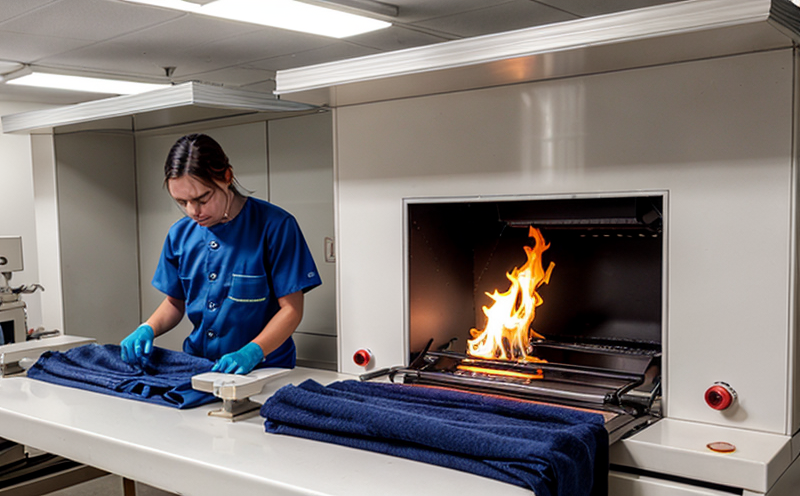BS 5867-2 Curtains, Drapes and Blinds – Flame Retardant Requirements
The British Standard BS 5867-2 sets out essential requirements for curtains, drapes, and blinds intended to be used in domestic or other similar environments. This standard ensures that these textiles are flame retardant to prevent the spread of fire, protecting users from potential hazards. Understanding this standard is crucial for quality managers, compliance officers, R&D engineers, and procurement professionals involved in textile production.
The testing procedure under BS 5867-2 involves exposing a specimen to controlled flames for a specified duration and observing its reaction characteristics. The primary focus of the test is on determining how effectively the fabric resists burning. This includes assessing the rate at which the flame spreads, the formation of smoke, and the overall performance of the material.
The standard specifies that specimens should be cut into specific sizes to ensure consistent testing conditions. Specimen preparation typically involves cleaning them thoroughly with mild detergent followed by drying under controlled conditions before being conditioned in a non-air-conditioned room at 21°C ± 3°C and relative humidity between 45% and 60%.
The apparatus required for conducting the test includes a specialized flame source, a calorimeter to measure heat release rates, and a smoke chamber. These instruments are calibrated according to international standards (ISO, ASTM) ensuring accurate measurement and reproducibility of results.
| Test Parameters | Description |
|---|---|
| Flame Exposure Duration | The length of time for which the specimen is exposed to flames (typically 15 seconds). |
| Specimen Size | Dimensions specified in the standard, ensuring uniformity across different samples. |
| Calorimeter Reading | Measurement of heat released during combustion. |
| Smoke Measurement | Quantification of smoke produced by burning specimens. |
The results of the test are interpreted based on predefined acceptance criteria outlined in the standard. Compliance with these criteria indicates that the product meets safety standards for use within specified environments. Non-compliance may lead to recall or redesign of products, affecting market reputation and customer trust.
Understanding BS 5867-2 is vital not only for compliance but also for improving product design and performance. By incorporating flame retardant treatments that meet these stringent requirements, manufacturers can enhance fire safety measures significantly. This ensures consumer protection while contributing positively to public health and safety policies.
International Acceptance and Recognition
- BS 5867-2 is widely recognized in the UK for ensuring domestic curtain, drape, and blind products are flame retardant.
- The standard has been adopted by other countries like Ireland due to its stringent requirements.
- Australia also references similar standards for comparable products.
Manufacturers who adhere to BS 5867-2 benefit from broader market access opportunities internationally, as many global retailers and buyers specify compliance with this standard. This recognition enhances brand reputation and customer confidence in the products offered.
| Countries Recognizing BS 5867-2 | Recognition Level |
|---|---|
| UK | Primary Compliance Requirement |
| Ireland | Secondary Compliance Requirement |
| Australia | Reference Standard for Comparable Products |
The global acceptance of BS 5867-2 underscores its importance in establishing consistent safety benchmarks across borders. Adherence to this standard not only meets regulatory requirements but also demonstrates a commitment to quality and consumer protection.
Competitive Advantage and Market Impact
Compliance with BS 5867-2 provides several competitive advantages for textile manufacturers:
- Increased market share: Meeting safety standards increases the likelihood of product acceptance by retailers and consumers.
- Better brand reputation: Demonstrating a commitment to fire safety enhances consumer trust and loyalty.
- Reduced liability risk: Ensuring compliance minimizes potential legal issues related to product safety.
In terms of market impact, adherence to this standard can lead to higher sales volumes due to increased demand for safer products. Additionally, it allows companies to tap into international markets where similar standards are required or recommended.
For R&D engineers and quality managers involved in textile development, understanding and implementing BS 5867-2 ensures they stay ahead of regulatory changes while improving product design and performance. This proactive approach helps maintain a competitive edge in the highly regulated textile industry.
Use Cases and Application Examples
| Application Area | Description |
|---|---|
| Homes | Curtains, drapes, blinds used in residential settings must comply with BS 5867-2 to ensure fire safety. |
| Dormitories | Textile furnishings for student housing are required to meet these stringent flame retardant standards. |
| Nursing Homes | Safety and comfort are paramount in senior living facilities, making compliance with this standard essential. |
In each of these applications, the primary goal is to protect occupants from potential fire hazards. The robust testing procedures under BS 5867-2 ensure that textiles used in these environments meet high safety standards, thereby contributing to overall public health and safety.
Manufacturers who utilize this standard can showcase their commitment to quality and safety, which translates into better market positioning and customer satisfaction.





